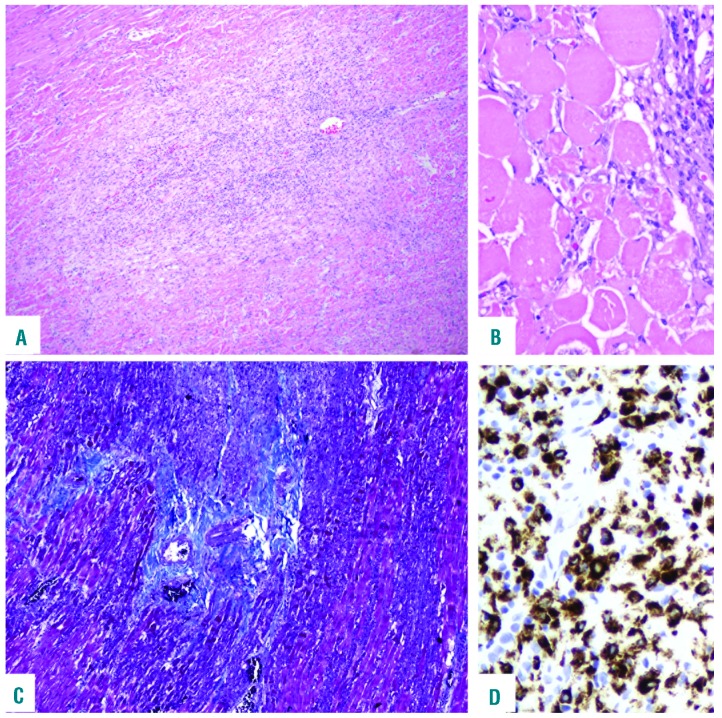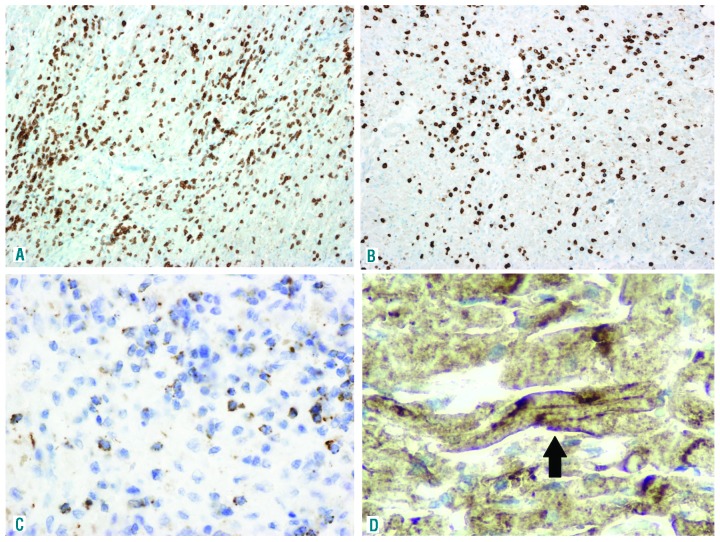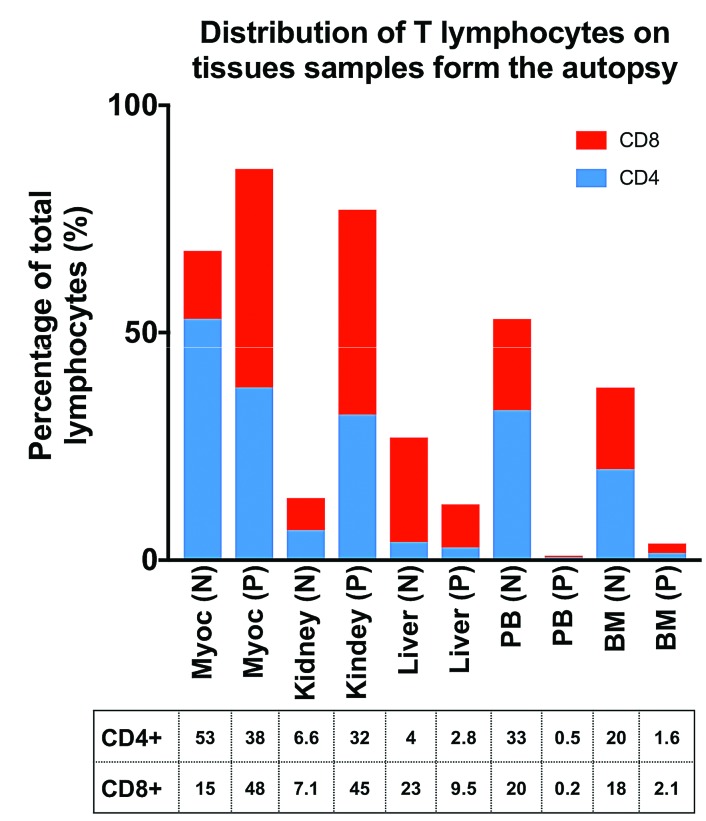Multiple myeloma is a promising candidate for anti-PD1 checkpoint inhibitor therapy.1–3 Results of phase I trials of pembrolizumab, in combination with lenalidomide or pomalidomide in relapsed/refractory patients have shown encouraging results. These trials showed a 35% and 65% response rate in patients already refractory to IMIDs with a median PFS of 7.2 and 14 months for the lenalidomide and pomalidomide combinations, respectively.4,5 These positive results prompted the activation of phase III trials, which are currently underway in relapsed (clinicaltrials.gov identifier 02576977) and first-line setting (clinicaltrials.gov identifier 02579863). Immune-related adverse events (irAE) as a result of uncontrolled activation of autoreactive T-cells,6 are the most important emerging safety issues of checkpoint inhibitors. Myocarditis is rare among the irAE; however, several cases of lethal immune-related myocarditis have recently been published.7–9 The Nivolumab patient database has revealed an incidence of myocarditis of 0.09% in over 20,000 patients already treated;7 however, this figure may be an underestimation since only symptomatic cases were recorded. Myocarditis seems to be frequent with the nivolumab-ipilimumab combination (0.27%), with two reports of a lethal outcome.8 To the best of our knowledge, no fatal cases have been reported with pembrolizumab or nivolumab as single checkpoint inhibitor agents. Here, we report a newly diagnosed multiple myeloma patient who developed a lethal immune-related myocarditis after a single dose of pembrolizumab, which was combined with lenalidomide and dexamethasone, not with other checkpoint inhibitors.
A 67-year-old female was diagnosed with free light-chain lambda multiple myeloma. Medical history included localized bilateral breast carcinoma treated with surgery and radiotherapy in 2007 and absence of prior cardiovascular history. First-line treatment was started within a randomized clinical trial (clinicaltrial.gov identifier 02579863) comparing Lenalidomide-Dexamethasone +/−pembrolizumab (assigned to the pembrolizumab combination arm). On day 16 of the first treatment cycle, the patient presented to the emergency room with a 2-day history of malaise and 24-hour history of dyspnea on minimal exertion. Oxygen saturation was 85% on ambient air. Chest X-ray was normal. Laboratory tests showed elevation of liver function tests (<10 times the upper normal limit [ULN]; AST 346 UI/L; ALT 248 UI/L; ALP 123 UI/L; GGT 195 UI/L) and an important elevation of cardiac biomarkers (hs-Troponin-T 9.71 ng/mL [ULN=0.0035 ng/mL], CK 3689 UI/L [ULN 170 UI/L]; CK-MB 300 ng/mL [ULN 4,88 ng/mL]). ECG revealed newly appearing anterolateral ST-segment elevation, and right bundle-branch block (baseline ECG was normal). Echocardiogram showed depressed ventricular contractil ity without focal hypokinesis. Coronariography discarded ischemic cardiomyopathy, leaving myocarditis as the most plausible diagnosis. Myocarditis was deemed immune-related based on the temporal relationship with pembrolizumab dose. Viral cultures and viral-respiratory PCR were negative. Treatment with methylprednisolone 1.5 mg/kg was started.9,10 Cardiac function progressively deteriorated; 24h after admission ECG showed flares of ventricular tachycardia and complete AV-block. LVEF dropped below 30%, leading to renal failure and requiring an ECMO device to sustain cardiac output. In the absence of improvement after 48h of ECMO assistance, infliximab (5mg/kg) was added as a second-line immunosuppressive treatment. No immediate response was observed and despite maximal support, the patient progressed to multi-organ failure and expired 10 days after admittance. Autopsy revealed necrotizing immune myositis and myocarditis with cellular infiltrate of CD3+/CD8+/CD56+/Tia+/PD1- cytotoxic T cells (CTL), CD3+/CD4+/FOXP3− lymphocytes and CD68+/CD163+ macrophages. Several foci of collagen fibrosis were also seen in the myocardium (Figures 1 and 2). No amyloid was detected. Bone marrow showed persistence of 11% kappa-restricted plasma cells (25% at diagnosis) with PD-1 expression comparable to normal hematopoietic cells. The lymphocytic infiltrate was characterized by flow cytometry, showing >60% of T cells in myocardium and kidney with an increase in CD8+ cells compared to normal parameters (Figure 3). CD8+ T-cell infiltrates were predominantly central (CD28+/CCR7+) and effector memory (CD28−/CCR7−). Of note, most CD8+ lymphocytes expressed perforin and dimCD28, suggestive of recent activation. All T cells in both IHC and flow cytometry showed negative PD-1 signal, consistent with binding interference of pembrolizumab with the PD-1 diagnostic antibodies, and suggestive of adequate PD-1 engagement of the drug. The presence of cardiac anti-troponin antibodies was retrospectively investigated on pre-treatment samples; remarkably, the patient resulted positive for cardiac troponin autoantibodies (kindly performed by Dr. Pettersson, University of Turku, Finland).11 Baseline cardiac biomarkers were also performed showing normal CK-MB (2.9 ng/mL; ULN 4,88ng/mL), normal pro-BNP (126 pg/mL; ULN 222 pg/mL), and elevated troponin-T (21.6 ng/mL; ULN 14 ng/mL).
Figure 1.
Autopsy showed multifocal lymphocytic myositis and myocarditis. A. Patchy necrotizing lymphocytic infiltration is observed in the myocardium (A; H&E, 40×) and skeletal muscle (B; H&E, 200×). Multiple sites of focal fibrosis were also found in the myocardium (C, Masson Trichrome, 40×.) Multifocal CD68+ macrophage infiltration accompanied lymphocytic infiltration of the myocardium (D; Anti-CD68 immunostaining, 200×).
Figure 2.
Characterisation of lymphocytic infiltrates in the myocardium. Dense cytotoxic T-cell infiltrates were observed within the myocardium and the skeletal muscle. Representative image of immunostaining against CD8+ (A, 100×), granzyme B (B, 100×) and perforin (C, 100×) in myocardium slides. Cardiomyocytes (arrow) around necrotic areas showed intense membrane PD-L1 expression (D, PD-L1 clone 22C3, 100×).
Figure 3.
Comparative analysis of T-cell subsets from autopsy samples. Flow cytometry analysis of CD8+ (red) and CD4+ (blue) T-cell subset frequencies on different tissue samples. Bars represent percentage of total lymphocytes. Myoc: Myocardium; PB: Peripheral Blood; BM: Bone Marrow; N: Normal values; P: Patient. For comparison, normal values were extracted from literature: Myocardium (PMID: 9024980); Kidney (PMID: 18765477); Peripheral Blood (PMID: 10366792); Bone Marrow (PMID: 1700596).
The development of myocarditis with a single dose of pembrolizumab suggests some degree of idiosyncrasy in our patient case. A role of common epitopes between neoplastic and muscular tissues has been suggested;7 however, myeloma cells are unlikely to express muscular proteins. HLA-related susceptibility to muscle damage by checkpoint blockade has also been assessed but not proven in previously published cases.7 Pre-existing immunity is also a plausible explanation for the development of irAE. In fact, history of autoimmunity is a major exclusion criteria for checkpoint inhibitor trials. Extrapolating vaccination-induced immunity, de novo antigen presentation and B-cell response is very unlikely to have occurred in only 2 weeks. Thus, the quick onset of myocarditis was suggestive of a pre-existing T-memory response (known to peak 7-9 days after stimulation), boosted after PD-1 blockade. This hypothesis is further supported by the presence of baseline anti-troponin T antibodies (indicative of B-memory response), the baseline elevation of troponin T and the myocardial fibrosis found in the autopsy. Early onset of autoimmunity might in fact be a feature of bad prognosis as similar cases showed no response to steroids and second-line therapy.7 Cardiac and striated muscle co-involvement in autoimmune myositis has been described, suggesting a common muscular epitope(s).12,13 Viral Influenza-A myocarditis has also been associated with concomitant myositis in 10% of cases.14 In fact, the clinical presentation of our case is compatible with early-onset myositis, which evolved later to affect the myocardium. This is in fact a possible explanation for the severity of cardiac involvement, as the epitope abundance could have contributed to the uncontrolled T-cell response. Interestingly, an analogue case with myositis and rhabdomyolisis related to nivolumab/ipilimumab,15 revealed high titers of pre-existing antibodies against striated muscle, supporting that subclinical autoimmunity may be exacerbated by checkpoint inhibitor therapy. Possible causes of pre-existing autoimmunization include previous chest radiotherapy, a silent cardiomyopathy or an overlooked previous episode of myocarditis. The review of the cases of myocarditis on previously irradiated patients among lung, breast and GI tumor cohorts did not show a clear association between radiation therapy and myocarditis (Merck patient database, unpublished observations). Another aspect that merits discussion is the trial design combining IMIDs and anti-PD1 antibodies.4,5 In multiple myeloma, checkpoint inhibitors are being incorporated into traditional backbone regimens (i.e., lenalidomide and pomalidomide). Although these combinations are associated with increased efficacy, they could also be accompanied by increased incidence of irAE. The accumulating experience from the clinical trials will soon unveil this aspect. This case depicts the potential severity and lethality of checkpoint inhibitors-induced myocarditis and the potential role of pre-existing autoimmunity. Currently, only baseline ECG is done for patients treated with pembrolizumab. The debate is open as to whether determination of additional cardiac biomarkers should be performed at baseline. Anti-troponin antibodies still have an undefined role in this setting, but may serve as potential biomarkers to predict myocardial autoimmune attack.
Special care should be taken when administering checkpoint inhibitors to patients who have history of cardiac disease, probably including those with previous chest RT and/or anthracyclines. Baseline TT echocardiogram might be advisable, whilst biomarkers for prediction of myocardial immune-mediated damage and/or early diagnosis of myocarditis should be explored; baseline troponin and CK-MB might be appropriate candidates. Efforts should be made to detect early signs of myocarditis and prompt initiation of therapy. The presence of unspecific or mild cardiorespiratory symptoms (e.g., dyspnea) during the first cycles of treatment should alert physicians to avoid delaying the start of appropriate treatment.
Supplementary Material
Footnotes
Information on authorship, contributions, and financial & other disclosures was provided by the authors and is available with the online version of this article at www.haematologica.org.
References
- 1.Hallett WHD, Jing W, Drobyski WR, Johnson BD. Immunosuppressive effects of multiple myeloma are overcome by PD-L1 blockade. Biol Blood Marrow Transp. 2011;17(8):1133–1145. [DOI] [PubMed] [Google Scholar]
- 2.Kearl TJ, Jing W, Gershan JA, Johnson BD. Programmed death receptor-1/programmed death receptor ligand-1 blockade after transient lymphodepletion to treat myeloma. J Immunol. 2013;190(11):5620–5628. [DOI] [PMC free article] [PubMed] [Google Scholar]
- 3.Paiva B, Azpilikueta A, Puig N, et al. PD-L1/PD-1 presence in the tumor microenvironment and activity of PD-1 blockade in multiple myeloma. Leukemia. 2015;29(10):2110–2113. [DOI] [PubMed] [Google Scholar]
- 4.Badros A, Hyjek E, Ma N, et al. Pembrolizumab, pomalidomide and low dose dexamethasone for relapsed/refractory multiple myeloma. Blood. 2017;130(10):1189–1197. [DOI] [PubMed] [Google Scholar]
- 5.Mateos M-V, Orlowski RZ, Siegel DSD, et al. Pembrolizumab in combination with lenalidomide and low-dose dexamethasone for relapsed/refractory multiple myeloma (RRMM): Final efficacy and safety analysis. J Clin Oncol. 2017;34(14):8010. [Google Scholar]
- 6.Michot JM, Bigenwald C, Champiat S, et al. Immune-related adverse events with immune checkpoint blockade: a comprehensive review. Eur J Cancer. 2016;54(1):139–148. [DOI] [PubMed] [Google Scholar]
- 7.Johnson DB, Balko JM, Compton ML, et al. Fulminant myocarditis with combination immune checkpoint blockade. N Engl J Med. 2016;375(18):1749–1755. [DOI] [PMC free article] [PubMed] [Google Scholar]
- 8.Läubli H, Balmelli C, Bossard M, Pfister O, Glatz K, Zippelius A. Acute heart failure due to autoimmune myocarditis under pembrolizumab treatment for metastatic melanoma. J Immunother Cancer. 2015;3:11. [DOI] [PMC free article] [PubMed] [Google Scholar]
- 9.Tadokoro T, Keshino E, Makiyama A, et al. Acute lymphocytic myocarditis with Anti-PD-1 antibody nivolumab. Circ Heart Fail. 2016;9(10):e003514. [DOI] [PubMed] [Google Scholar]
- 10.Weber JS, Postow M, Lao CD, Schadendorf D. Management of adverse events following treatment with anti-programmed death-1 agents. Oncologist. 2016;21(10):1230–1240. [DOI] [PMC free article] [PubMed] [Google Scholar]
- 11.Pettersson K, Eriksson S, Wittfooth S, Engström E, Nieminen M, Sinisalo J. Autoantibodies to cardiac troponin associate with higher initial concentrations and longer release of troponin I in acute coronary syndrome patients. Clin Chem. 2009;55(5):938–945. [DOI] [PubMed] [Google Scholar]
- 12.Denbow CE, Lie JT, Tancredi RG, Bunch TW. Cardiac involvement in polymyositis: a clinicopathologic study of 20 autopsied patients. Arthritis Rheum. 1979;22(10):1088–1092. [DOI] [PubMed] [Google Scholar]
- 13.Lundberg IE. Cardiac involvement in autoimmune myositis and mixed connective tissue disease. Lupus. 2005;14(9):708–712. [DOI] [PubMed] [Google Scholar]
- 14.Kumar K, Guirgis M, Zieroth S, et al. Influenza myocarditis and myositis: case presentation and review of the literature. Can J Cardiol. 2011;27(4):514–522. [DOI] [PubMed] [Google Scholar]
- 15.Bilen MA, Subudhi SK, Gao J, Tannir NM, Tu S-M, Sharma P. Acute rhabdomyolysis with severe polymyositis following ipilimumab-nivolumab treatment in a cancer patient with elevated anti-striated muscle antibody. J Immunother Cancer. 2016;4:36. [DOI] [PMC free article] [PubMed] [Google Scholar]
Associated Data
This section collects any data citations, data availability statements, or supplementary materials included in this article.





